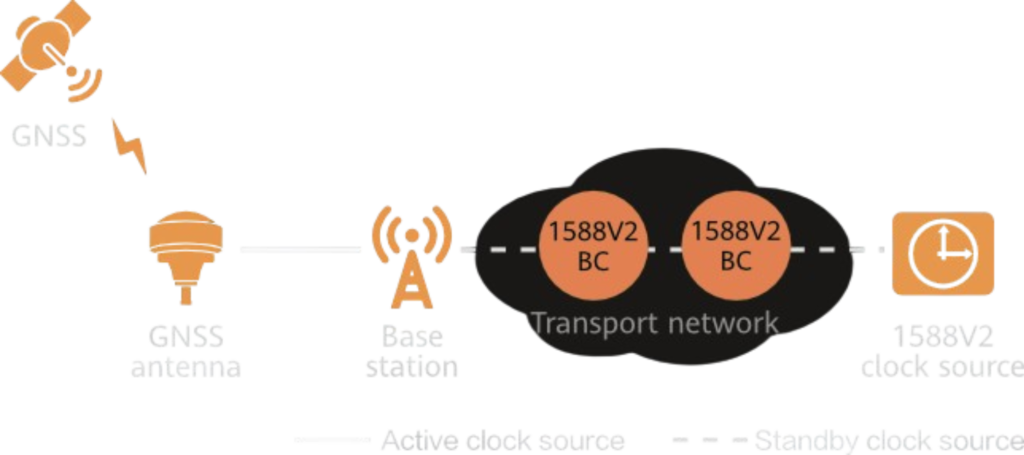1. Synchronization with GNSS.
Global Navigation Satellite Systems (GNSS) like GPS, BeiDou, GLONASS, and Galileo provide precise satellite-based clock solutions for base stations. GNSS supports microsecond-level accuracy, enabling both time and frequency synchronization critical for modern communication networks. These systems offer high-precision positioning, navigation, and timing services, ensuring reliable synchronization for diverse applications. GNSS-based synchronization is widely used in telecommunications to maintain consistent network operations and prevent timing discrepancies that could affect service quality. A typical GNSS synchronization setup integrates base stations with satellite timing sources for optimal accuracy.

Satellite cards are integral components for GNSS synchronization and come in two types: multimode and single-mode. Multimode satellite cards, like UBLOX8M, can track multiple satellite systems such as GPS, GLONASS, BDS, and Galileo, offering greater flexibility. Single-mode satellite cards, such as UBLOX6T, are limited to tracking a single satellite system, like GPS. These cards can be integrated with network boards like LMPT, UMPT, and USCU, but compatibility depends on the specific board type and its supported satellite card capabilities.
Multimode satellite cards enable joint and concurrent tracking of satellites from multiple satellite systems, enhancing synchronization precision. In dual-satellite-system tracking, satellites from two systems operate simultaneously, complementing each other to meet clock synchronization requirements. For example, in GPS/BDS mode, synchronization is achieved if at least five satellites are tracked, with no fewer than four from one system, such as four GPS satellites and one BDS satellite. This capability ensures reliable synchronization even in scenarios with limited visibility of satellites from a single system.

Only the following combinations of satellite systems support the joint and concurrent tracking mode:
- GPS and BDS.
- GPS and Galileo.
- GPS and GLONASS.
- GPS, BDS, and Galileo.
- GPS, Galileo, and GLONASS.
- GPS, BDS, Galileo, and GLONASS (supported only by the book BBU).
2. 1588V2 Synchronization.
The 1588V2 synchronization method is widely used in IP and Ethernet transport networks, providing microsecond-level accuracy for both time and frequency synchronization. It achieves this by exchanging 1588V2 messages that include precise timestamps, enabling devices to calculate time and frequency offsets. To support 1588V2 time synchronization, all intermediate network devices must implement boundary clock (BC) or transparent clock (TC) functionality. For optimal performance, a network-wide BC architecture and Layer 2 multicast mode are recommended, ensuring precise synchronization across the network.

Boundary Clock (BC) and Transparent Clock (TC) are key elements in 1588V2 synchronization. BC operates on a point-to-point basis with multiple Precision Time Protocol (PTP) communication ports, allowing each node to synchronize with its parent node, simplifying fault location during synchronization issues. Layer 2 multicast mode, commonly used with BC, avoids negotiation and eases equipment interconnection.
TC measures link delays and compensates for processing delays without full synchronization. However, fault localization is more challenging. Base stations support 1588V2 in both Layer 3 unicast (using IPv4/IPv6 UDP packets) and Layer 2 multicast (using MAC packets).
1588V2 synchronization defines different profiles, as described in below table.
| Profile | Networking Mode | Synchronization Mode |
|---|---|---|
| G.8275.1 | Layer 2 multicast | Time synchronization |
| G.8275.2 | Layer 3 unicast | Time synchronization |
| G.8265.1 | Layer 3 unicast | Frequency synchronization |
| 1588V2 | Layer 3 unicast | Frequency synchronization |
| 1588V2 | Layer 2 multicast | Time and frequency synchronization |
| 1588V2_16.1 | Layer 3 unicast | Time and frequency synchronization |
3. 1588V2 Loose Time Synchronization.
1588V2 loose time synchronization is a cost-effective solution for time synchronization with lower precision requirements. It works by having a 1588V2 clock server at the core network send synchronization information transparently through the intermediate transport network to base stations. Base stations extract frequency and time details from the transmitted information. This approach is easy to deploy as it does not require the intermediate transport network to support 1588V2 Boundary Clock (BC) at each hop, and it places minimal requirements on the transport network equipment.

The 1588V2 loose time synchronization function is particularly useful in FDD networks, where precise clock reconstruction may be challenging. It helps avoid issues in scenarios like LTE FDD and NR TDD dual connectivity (NSA), LTE and NR FDD spectrum sharing, and NR FDD-only configurations. In these cases, it prevents problems such as setup failures, low throughput, and service drops by ensuring proper time synchronization, particularly when specific NR parameters like the SSB period are adjusted.
4. GNSS+1588V2 Synchronization.
GNSS+1588V2 synchronization is considered the optimal solution for 5G. In this system, GNSS serves as the primary clock source, and 1588V2 functions as a backup. If the GNSS clock becomes faulty, the base stations automatically switch to the 1588V2 clock to maintain normal operation, ensuring high synchronization precision and reliability for 5G networks.

Here is a summary of the clock sources for synchronization in 5G:
- GNSS: High precision, supports FDD and TDD, provides both frequency and time synchronization.
- 1588V2: High precision with network-level protection, supports FDD and TDD, provides both frequency and time synchronization.
- 1588V2 Loose Time Synchronization: Cost-effective, easy to deploy, but low precision, supports FDD, and provides time synchronization.
- GNSS + 1588V2: High precision and reliability, supports FDD and TDD, provides time synchronization.
Prerequisites for this article are: